“Honestly, I am just admiring your .beer mug!“
Editor’s note: The only difference between a mug and a stein is the lid. Some mugs were steins and lost their lids (as just below ▼) ,
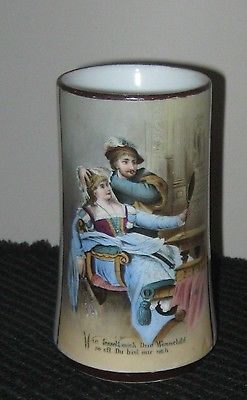
and some steins were made as mugs and had the lids added later. Even to this day beer stein repairers in the US are adding lids to steins. When this is known to have been done sometime in the past or done at their present day request, the USA stein auctioneers usually call this “strap repaired.” It makes no sense, but that’ is what it is. I just can not fix stupid or deceit!
Have an interesting” mug” you think my readers would like to see? Please send me photos and description to:
Renaissance [1400 / 1500’s] bronze drinking vessels. a couple of nice examples are shown ▼
Bronze drinking mug Ca 1400’s.
Tis not “Patina” folks this is dirt, oxidation and years of neglect. All the green spots will clean up but they leave what I call “blister marks ” which are small patches of barely visible, eaten away metal surface and can easily be seen with a mag glass. This is one method to assist in documenting really old age of bronze and copper, but especially brass!
.
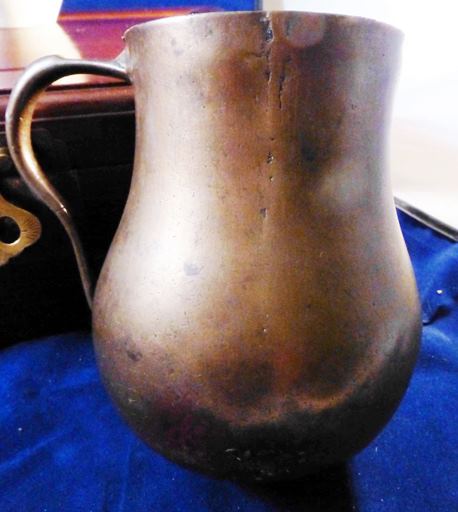
![SOS - A - Renaissance BRONZE DOUBLE HANDLED JUG PASS CUP [Q] handle is typical forr the period](http://www.steveonsteins.com/wp-content/uploads/2010/10/SOS-A-Renaissance-BRONZE-DOUBLE-HANDLED-JUG-PASS-CUP-Q-handle-is-typical-forr-the-period-630x442.jpg)
There is a small debate at Smith’s Museum and tavern on whether or not this bowl ▲ could be a “pass cup ” See: http://www.steveonsteins.com/pass-cups-a-short-history-new-12-26-10
– I am of the opinion that while this piece might not have been designed specifically for that use, as the lip is just a bit larger than it need be, it certainly could and probably was, used as such. The handles are well balanced for a quick sip of ale to the thirsty visitor and then passed around the table.! [Stephen Smith Collection ]
To see more on “Pass Cups” See: http://www.steveonsteins.com/pass-cups-a-short-history-new-12-26-10
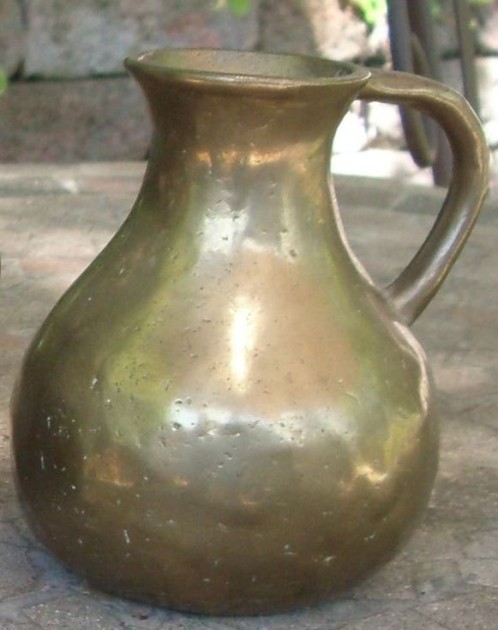
A bronze “towards the end of the renaissance” small bronze individual wine wine pitcher. the base is flattened on this example, the others above ▲ are somewhat rounded. Two part mold.
For more on individual wine pitchers, See:
pitchers[Stephen Smith Collection]
Below ▼From the New York Times [through Google ] originally Published at 12:01AM, September 17 2012.
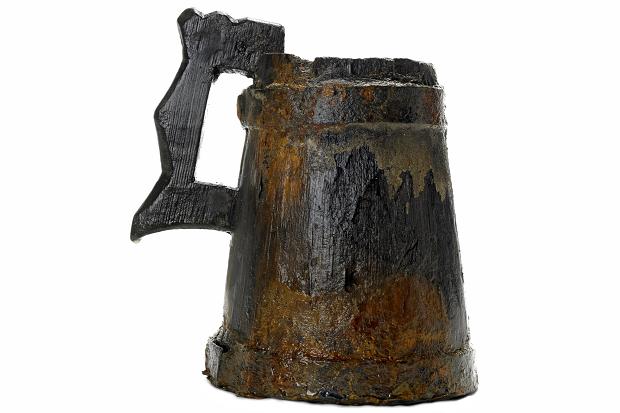
“The mug,It is the only surviving example from its era “
MORE AT [subscription required] http://www.thetimes.co.uk/tto/science/archaeology/article3540114.ece
[***** Editor;s note: given that handle design it well might have had a wooden lid attached] which is made from beech, is thought to date from the late 16th or early 17th century. and as it was so large it more than likely was used as a communal vessel or a”Pass Cup”
To see more on “Pass Cups” See: http://www.steveonsteins.com/pass-cups-a-short-history-new-12-26-10
![SOS - A - Renaissance BRONZE DOUBLE HANDLED JUG PASS CUP [Q] handle is typical forr the period](http://www.steveonsteins.com/wp-content/uploads/2010/10/SOS-A-Renaissance-BRONZE-DOUBLE-HANDLED-JUG-PASS-CUP-Q-handle-is-typical-forr-the-period-630x442.jpg)
The reader wiil please compare the pig tail handle finial on this pass cup / gruel / soup bowl [?] with the example above ▲ ▲.
There is a small debate at Smith’s Museum and tavern on whether or not this could be a pass cup – I am of the opinion that while this piece might not have been designed specifically for that use, as the lip os larger than it need be, it certainly could and probably was used for that. The handle are well balanced for a quick sip of ale to the thirsty visitor and then passed around the table.! [FWTD}
To see more on “Pass Cups” See: http://www.steveonsteins.com/pass-cups-a-short-history-new-12-26-10
A six foot tall “Black Forest” (really Swiss made) carved wooden hat rack & umbrella stand. Ca. 1850. Now used as a pewter “mug rack” at THE SM&T. These (the hat rack – not the mugs) go for good money at the high dollar auction houses, but be careful, as they are making very good replicas out of resin now!
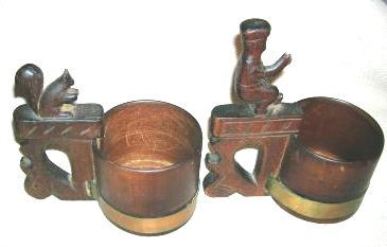
A pair of (1/4 liter ?) hand carved wooden character beer mugs, from Slovakia. Circa 1800-50 [FWTD] These should rate as a “6 ” on the Smith-Parator scale. The characters found on these mugs are of numerous designs and quite unique.
Silver mounted pottery relief, with thirteen grotesque faces. Ca. 1880. Quite different. No marks given. The eBay seller said: These might represent the “Thirteen faces of the Devil?” I do not know about them, (the devils) and I can not find a reference to them either. Although I believe this one is newer, , This should rate at least a “5 ” on the Smith-Parator scale.
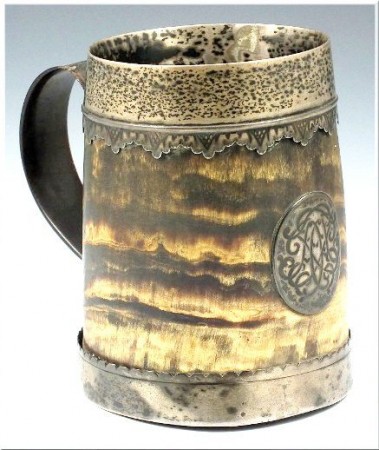
Above ▲- Described on eBay in 2012 as: “This great early mug has a steer or cattle horn body with silver mounts and a faux tortoise shell handle. It has a medallion on the front with chased design and has chased designs along the bottom edge of the rim. It has an American hallmark in two places along the edge of the rim. It dates from the 18th Century and measures approximately 5 inches tall by 4 inches diameter.”
The asking price was $2.8K!
But I immediately asked myself, “Why would the originators do that; use faux materials?” Could the makers have access to fake materials that far back? The below reference answered my question as I suspected!
Celluloid is derived from cellulose and alcoholized camphor. John Wesley Hyatt only invented celluloid as a substitute for the ivory in billiard balls in 1868. He first tried using collodion a natural substance, after spilling a bottle of it and discovering that the material dried into a tough and flexible film. However the material was not strong enough to be used as a billiard ball, until the addition of camphor, a derivative of the laurel tree. The new celluloid could be molded with heat and pressure into a durable shape. An interesting and nice looking mug non the less. This one might rate as a “5” on the Smith-Parator scale.
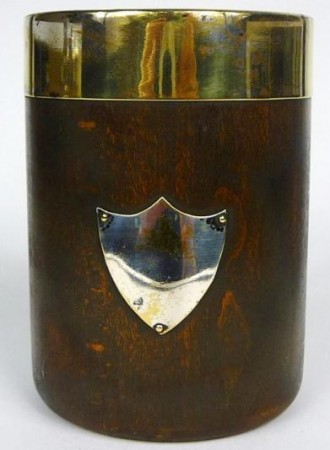
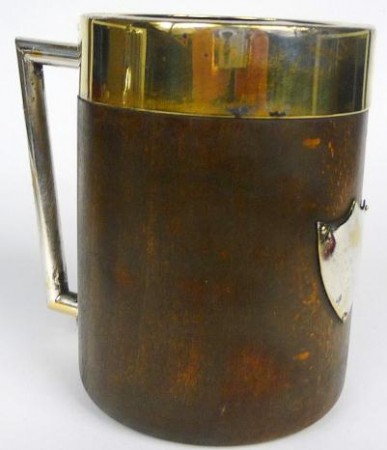
Of course smaller and less elaborate “Horn Mugs” such as shown above and below are easier to find, and much less expensive. Both ▲ and ▼ are English with sterling silver cartouches and lip mounts. Pre- 1900.
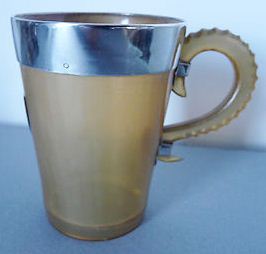
With a carved bone handle. These three ▲ should rate as a “4.5 ” on the Smith-Parator scale.
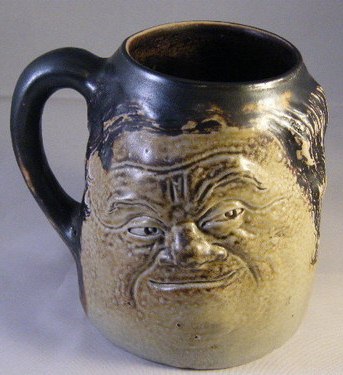
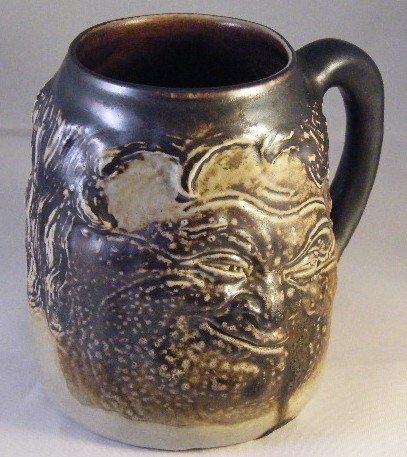
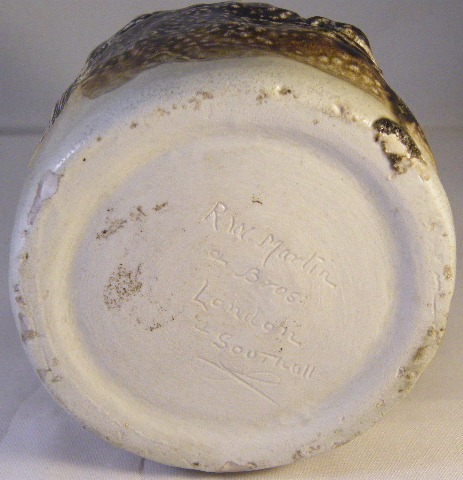
Face’s impressed mark.
Martin Brothers Pottery – For more on the Martin Brothers Pottery, see “Martin” in this site’s Compendium. This one should rate as a “5” on the Smith-Parator scale.
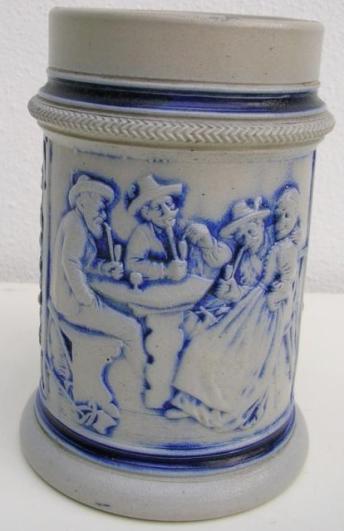

A frog mug (or stein) comes with a small applied pottery frog inside on the bottom of the piece, only apparent to the unsuspecting drinker when the vessel is emptied. Shown two above: A relatively sedate Westerwald .5 liter stoneware relief beer mug. Ca 1890.
Shown one above ▲: What awaits the beer drinker on completion. These are actually hard to find in German steins! Many examples in English pottery (esp. repros as below ) can be found, but not many within German beer vessels. This one should rate as a “5” on the Smith-Parator scale.
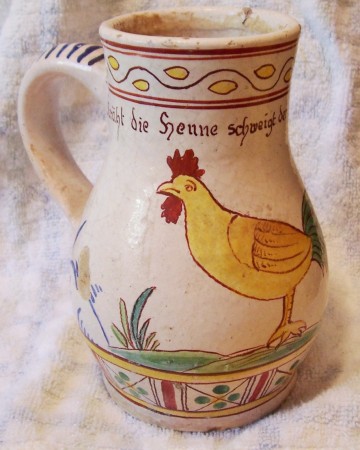
A 5 inch Fayence drinking “kinder mug” from Gmunden, Austria. [FWTD] Please notice the square with the X and the four dots around the bottom, which is very indicative of pieces made in this area. Circa 1850-80. This might rate as a “5.5” on the Smith-Parator scale.
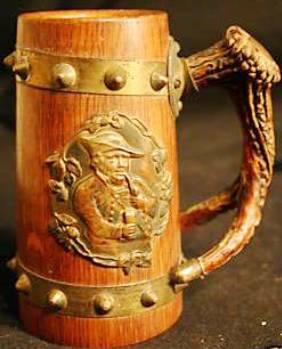
A 5.5 inch {?} German turned wooden body, with “faux” deer horn antlers anchored to two supporting brass rings and with a brass plaque riveted to the body. This one shows a Tyrolean man drinking. A lot of these have a phrase celebrating”Gambrinus and Bachus” ▼ . Circa 1890-1920. This might rate as a “4.5” on the Smith-Parator scale.
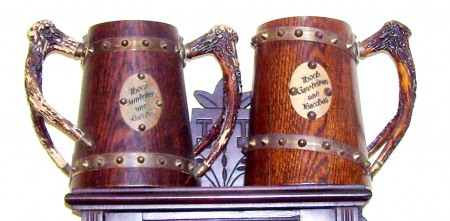
Two more in the same manufacturer’s series as above. [EX- FWTD] By the maker simply changing the center piece, there are several more to be found. These might rate as a “4.5 ” on the Smith-Parator scale.
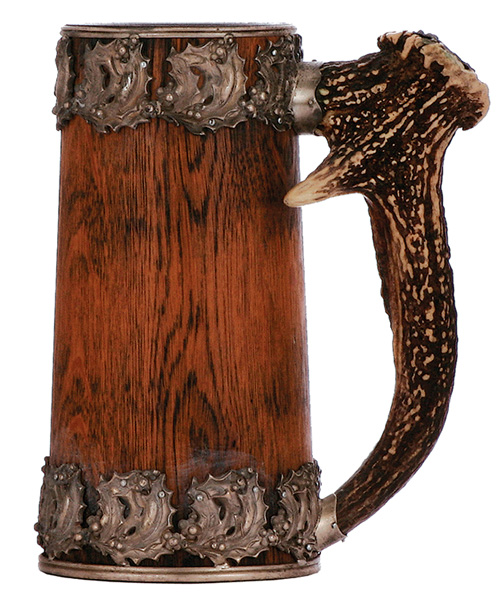
A much nicer edition by a different maker than those above. 1.0L, 9 in. ht., early 1900s, horn handle, sterling silver mounts. This might rate as a “5” on the Smith-Parator scale. [tsaco]
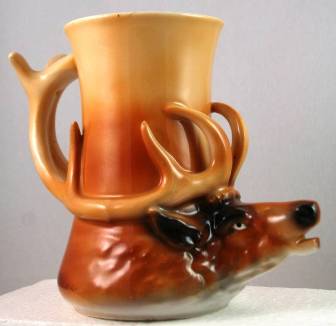
A Royal Bayreuth porcelain elk head beer mug. Bavaria mark, 5.75 Inches tall. This might rate as a “5” on the Smith-Parator scale
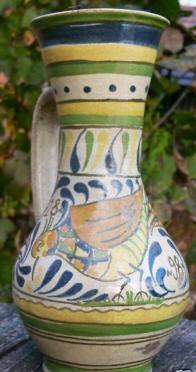
Another Slovakian beer mug. [FWTD] This one made of fayence, part of a pair both dated 1889. This might rate as a “5”on the Smith-Parator scale.
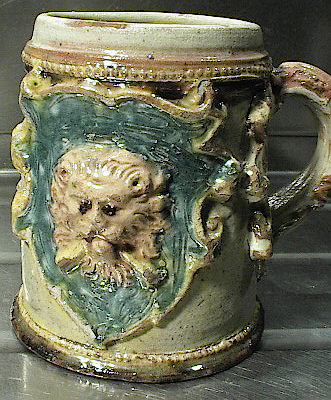
Spanish majolica (lead glaze) beer mug with molded and applied reliefs on the cartouches of Leon (Lion) and Castile (Castle.) 5 inches high. Circa late 1800’s. [Stephen Smith Collection] This might rate as a “5” on the Smith-Parator scale.
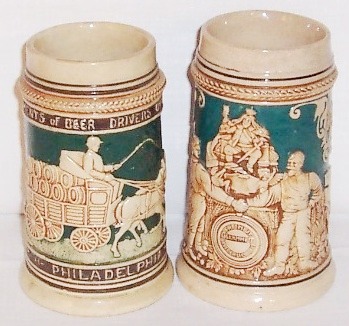
“Philly’s (PA.) Beer Driver’s Union, two non-lidded steins; “Occupationals”; both dated 1913. [Stephen Smith Collection]
These might rate as a “4” on the Smith-Parator scale.
American Beer maker’s mugs are highly collectable in the Brew-mania field here in the States. “Pabst – Milwaukee”, 1/2 liter mug. [FWTD] The original brewery was founded in 1844 as The Empire Brewery. This might rate as a “4” on the Smith-Parator scale.
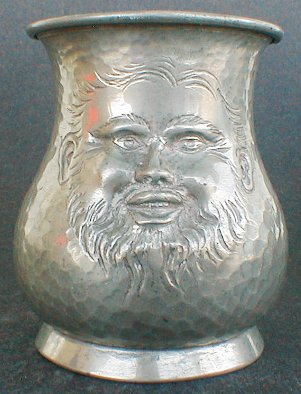
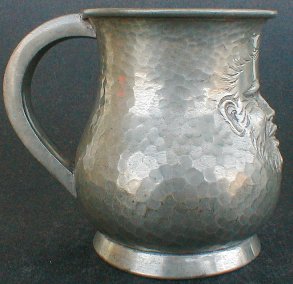
English pewter face mug, a miniature. George Lee & Co., Sheffield, England. 3 5/8″ high. CA. 1930. This might rate as a “6” on the Smith-Parator scale. (Courtesy WB)
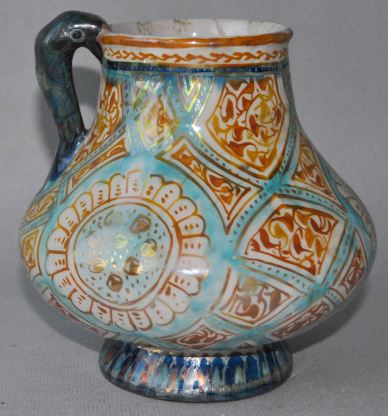
Delft art pottery, Islamic / Turk / Seljuq style, luster mug.T his might rate as a “5 ” on the Smith-Parator scale.
European monk playing violin. 5.25 in. tall. This might rate as a “5 ” on the Smith-Parator scale.
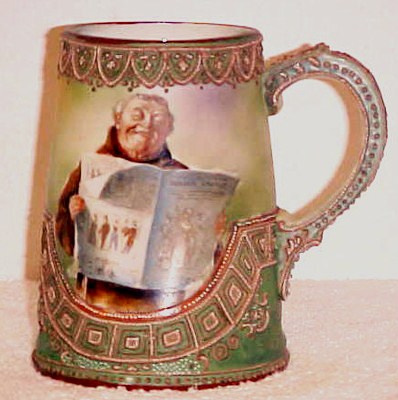
European monk reading paper. Obviously part of a series. 5.25 in. h.
Shown above ▲. Both Moriage; a style of porcelain decoration that places beads of prcelain on the item prior to kiln firing, and then painting them later. This creates a raised motif. This might rate as a “5” on the Smith-Parator scale.
About a one liter Russian brass and copper “Pass Cup” (mug), Circa 1880 -1910 [Stephen Smith Collection] These are highly collectable (most per-revolutionary Russian stuff is) but might only rate as a “4” on the Smith-Parator scale. Other examples of very old Russian mugs, but done in copper are just below.
Also see: http://www.steveonsteins.com/russian-antique-copper-vessles
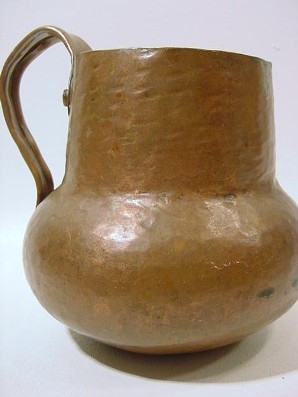
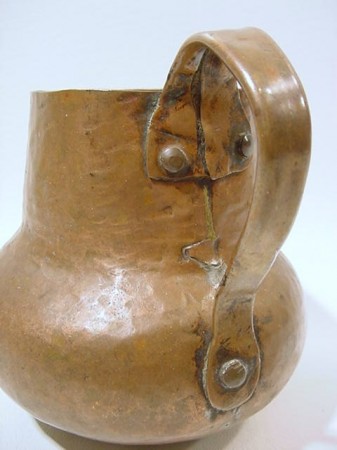
Above ▲. Russian or West Russian area. [FWTD] These little guys still have the pushed up bottoms which was popular in the Renaissance. (Called a “Kick.”) The handle edges are folded over for strength. Very well done, and I think done in the late early 1700’s. These might rate as a “5.5” on the Smith-Parator scale.
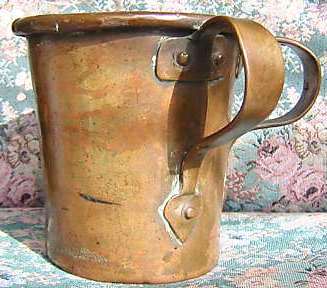
Above ▲. A very 5 inch tall typical antique Russian two handled mug or “Pass Cup” [FWTD] There is a lot of misconception and misinformation about these on the web and in the real world. While they “could be” used as Jewish hand washing cups most of those are inscribed, or leave someone the idea they are Jewish, such as an added relief plaque (See just below.) This might rate as a “4” on the Smith-Parator scale. They are very common, But lots of them are really well used [!] with severe cracks in the rolled rim; that could cut one’s lips if not used correctly.
Also see: http://www.steveonsteins.com/pass-cups-a-short-history-new-12-26-10
.
FROM A PRIOR EMAIL ABOUT THESES TWO HANDLED MUGS:
Well Harry, you asked:
To start with I’ve been a beer stein, tankard and drinking vessels collector for over 35 years now.
I’ve recently really got into Russian pre-revolution copper mugs and jugs. There is a lot of mis-information out there about these two (and even single) handled copper mugs.
As you advertised — they can and were used as Jewish hand washing vessels = “NETILLAT YADAYIM” VESSELS.
(I thought the fact that the little un-tinned one I got from you was made in Mexico was a hoot ▼ ▼ for Jewish tourists in Mexico City? or for the resident Jewish population? or for export? – it all bears further study.)
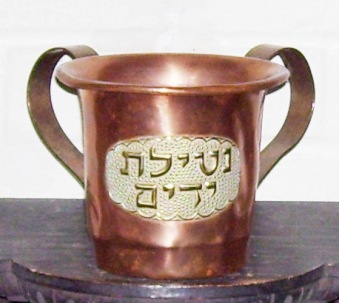
.
However what a lot of people don’t know is that this style mug was also used by the general populace, mostly orthodox Russians as [1] wedding cups [2] communal “pass cups” in bars and at parties.
The attached early NY Times article details one way they were used for marriages. They were also used a “betrothal cups” in the areas all over Europe that had visiting priests, as the padres only showed up in the local villages every 6 months or so. The partners to be married would drink from one of these in front of the village people and they were “unofficially married,” until such time as the priest showed up to do his thing.
The way to drink from them in this instance was: the man had hold of the handle furthermost from him and the lady held by the other handle, closer to the male. When the cup is raised to their mouths this way, the lips come together and both parties can sip from the cup at the same time = the basis for most true “marriage /wedding cups,” including the German Jungfrau wedding cup which has two cups one of which swings on a swivel, so the lady can drink from it at the same time the male does. Also see photo of one in silver. Anyway back to your, now mine, copper mug — it is tinned inside which means it was made with the purpose that it could be drunk out of. If not tinned like the smaller Mexican cup, one can use it for just the hand washing, hey?
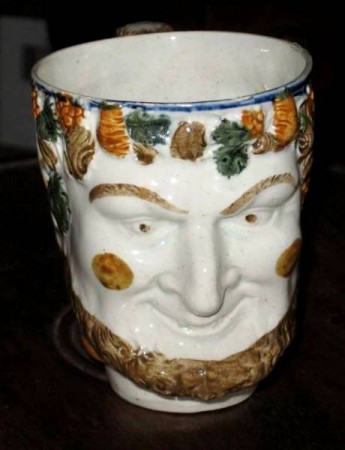
A creamware “Bacchus mug* (which is really Salinus who was Bacchus’s buddy and a Satyr.) Very English and they made quite a lot of “character mugs.” Many varieties exist; lots with ceramic frogs inside. This might rate as a “5” on the Smith-Parator scale.
Bohemian, a large chasted and engraved 11.5 liter copper mug. Late 1600’s- early 1700’s. Very nice workmanship.[FWTD] This might rate as a “7” on the Smith-Parator scale.
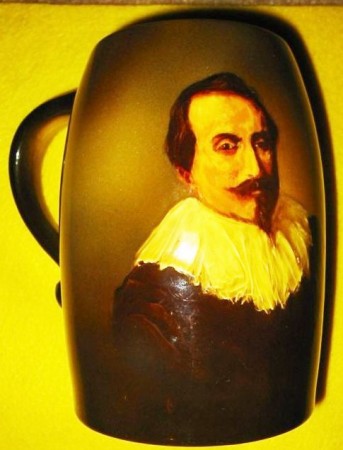
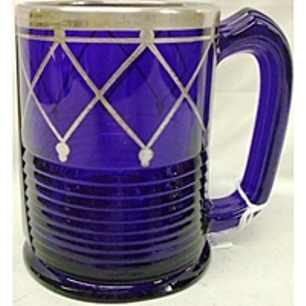
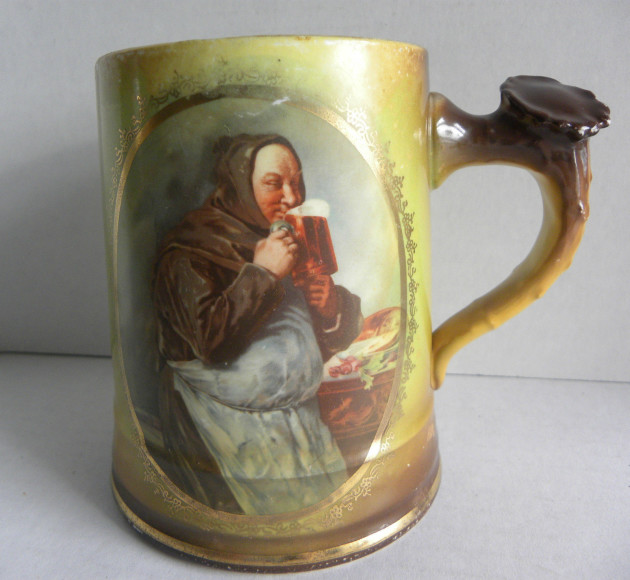
Monk-with a beer mug. “Homer Laughlin” Art – Porcelain handle in form of a Stag’s antler.This one should rate as a “4” on the Smith-Parator scale.
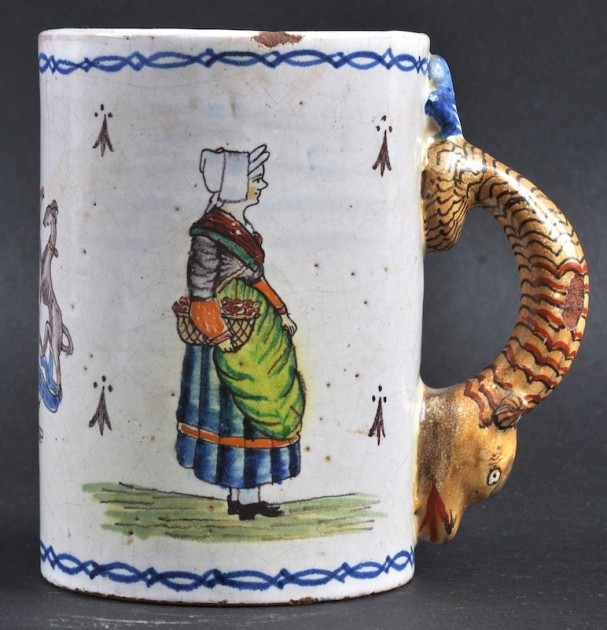
French Fayence -5 inches tall , quite an interesting handle. I assume most new collectors would call this “Quimper” – EVEN THOUGH IT IS NOT!!!This one should rate as a “4.5” on the Smith-Parator scale.
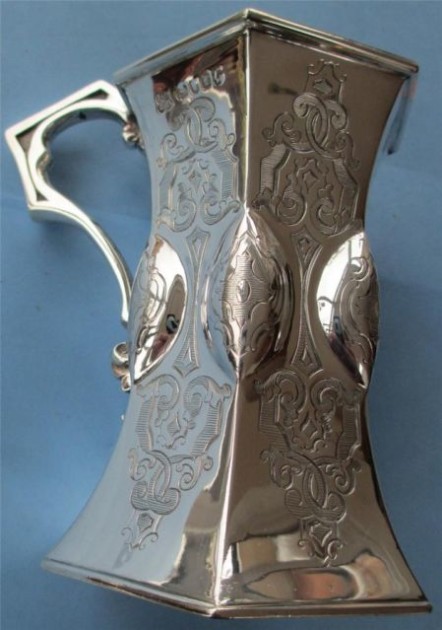
Gothic style mug [whatever that is (in beer mug design) by the seller] mug- marked HM-LONDON-1846. NO dimensions. I am not certain it won’t spill all over you should you be anything but really slow sipping out of it.This one should rate as a “5.5” on the Smith-Parator scale.
Ubaldo Vitali – is a master silver and goldsmith, born in 1944 in Rome, and now a resident of New Jersey. He executed designs in the 70’s for Bulgari, Tiffany, Cartier, Steuben and Movado.
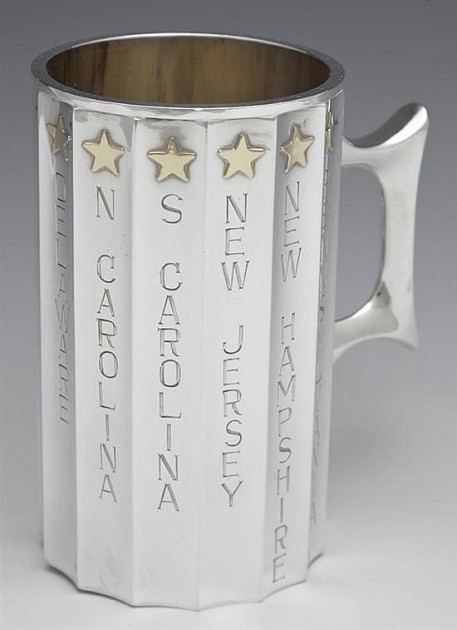
Unusual Bulgari Commemorative Sterling Tankard – c. 1975, commemorating the thirteen original colonies, the lobed sides with engraved decoration of the colonies’ names beneath a gold star, the underside stamped “UV,” for Ubaldo Vitali, “Bulgari,” “Sterling,” and “13-38, Now I do like this design! This one should rate as a “5.5” on the Smith-Parator scale.
” H.- 5 1/4 in., W.- 4 1/2 in., D.- 3 1/16 in., wt.- 16.55 troy oz.
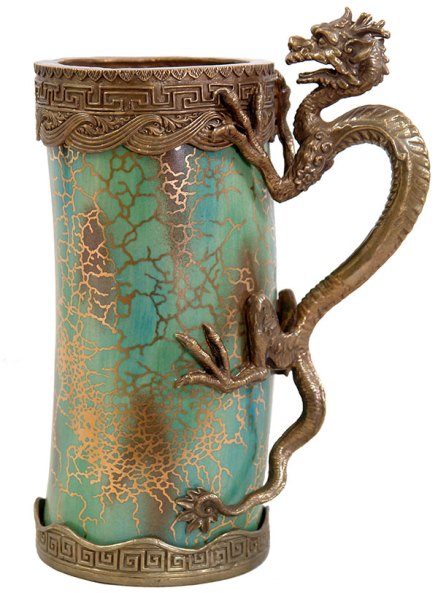
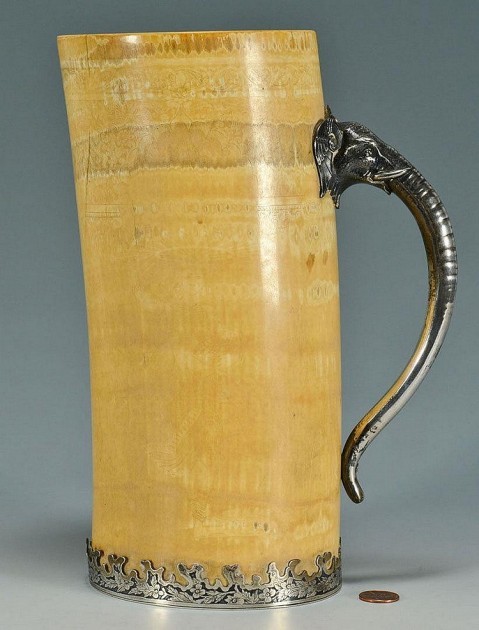
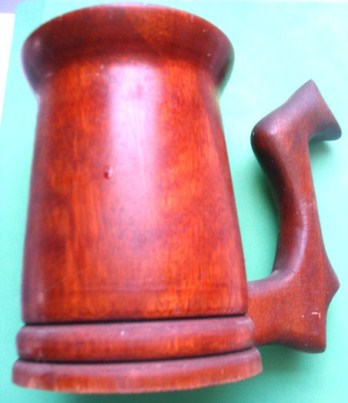
Hand made, turned wooden mug. English – 6 by 4 inches. Brand new! Just different which is why I posted it
__________________ AWPD = TO BE CONTINUED _____________
[END – SOK – 53 – R5]
 “The only perfect science is hindsight.”
“The only perfect science is hindsight.”
Below entries to be poster week of 2-23-15

English-Copper-Mug .with-different style Staghorn-Handle-6-IN-TALL
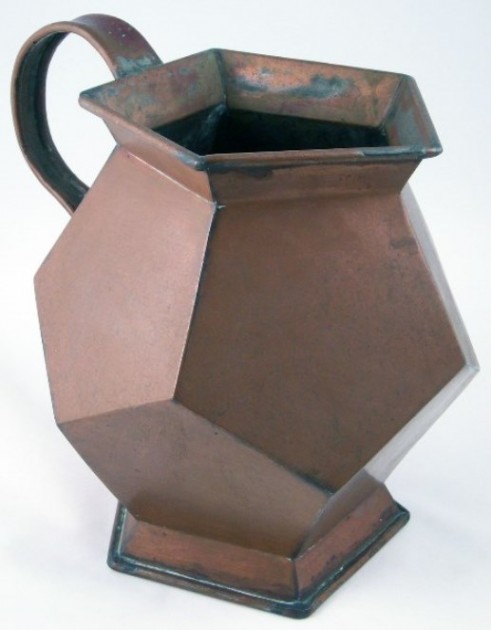
mug – ARTS-CRAFTS-COPPER-OR-MAYBE A-PITCHERB-HANDCRAFTED no size given
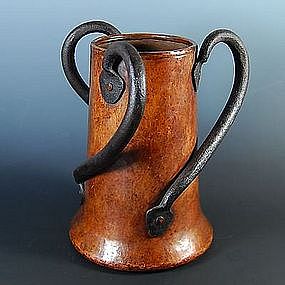
Some vases are mistaken as mugs and called such without much thought by the web’s sellers.
Due to the handle arrangement this might be a little hard to chug from. A damn shame they didn’t make them come into the body a little lower than the top, it would have been a nice looking piece.
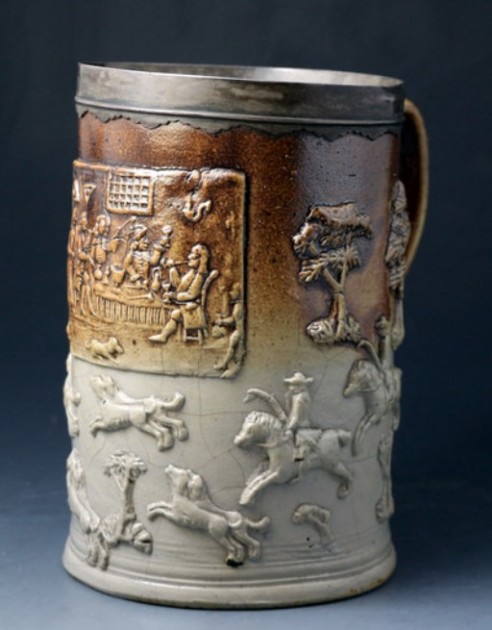
Harvest Mug, , called that in England, probably by Doulton, or Mortlake stoneware tankard with applied sterling silver liip =-early 19th century.


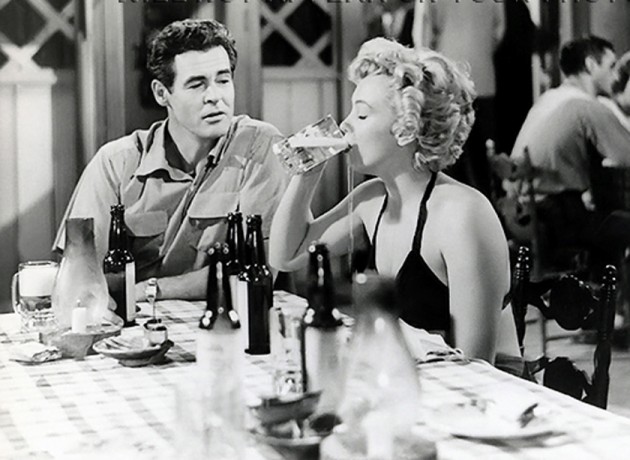
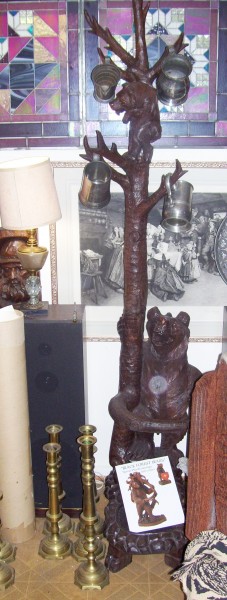
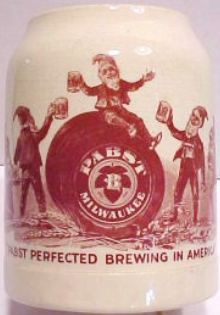
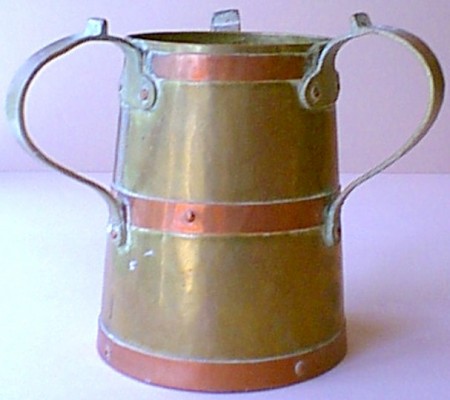
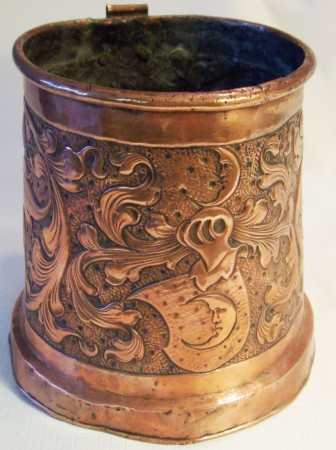
Leave a Reply